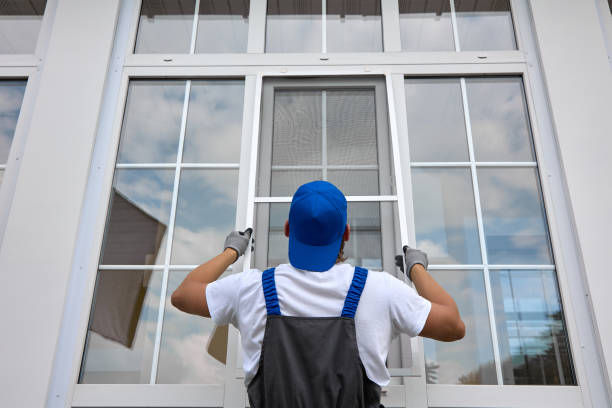Table of Contents
Replacing windows is a significant home improvement project that demands careful planning and consideration. This guide provides essential insights to help ensure a successful window replacement experience for your home.
• Understanding the Benefits of Window Replacement
Window replacement offers numerous benefits, making it a worthwhile investment for homeowners. First and foremost, new windows can significantly enhance the energy efficiency of your home. Modern windows are designed with advanced materials and technologies that reduce heat transfer, helping to maintain your home’s temperature and reducing energy bills.
• Assessing When It’s Time to Replace Your Windows
It’s crucial to recognize the signs that indicate window replacement is necessary. One of the most obvious signs is physical damage, such as warped frames, broken glass, or persistent drafts. Condensation buildup between glass panes, especially in double or triple-pane windows, is another signal that seals are failing. You may also notice an increase in energy bills, hinting your windows are no longer insulating effectively. Difficulty in opening or closing windows can suggest that frames have warped or that mechanical components have worn out. In older homes, windows with lead paint might pose health risks, requiring urgent replacement. Assess your current windows’ age; typically, windows over 15-20 years old may be due for an upgrade, especially if maintenance has been neglected.
• Choosing the Right Window Material
Selecting the right material for your new windows is crucial in terms of longevity, maintenance, and cost. The most common materials include wood, vinyl, fiberglass, and aluminum. Wood windows offer a classic look and excellent insulation but require regular maintenance to prevent rot and decay. Vinyl windows are highly popular due to their low cost, durability, and minimal maintenance. Fiberglass windows are gaining traction for their strength, low maintenance, and energy efficiency, though they come at a higher price point. Aluminum windows, while robust and sleek, are less thermally efficient but can be enhanced with thermal breaks. Each material has its pros and cons, and your choice will depend on your budget, aesthetic preferences, and the specific environmental conditions your home faces.
• Different Types of Window Styles
There are several window styles to consider, each offering unique benefits and aesthetic appeal. Double-hung windows are traditional and versatile, featuring two sashes that move up and down. Casement windows, which hinge on one side and open outward, provide excellent ventilation and unobstructed views. Sliding windows operate horizontally and are ideal for rooms with limited vertical space. Awning windows, hinged at the top, open outward to allow ventilation even during rain. Bay and bow windows project outward, creating additional interior space and offering expansive views, making them a focal point in living areas. Picture windows do not open but provide wide, unobstructed views and abundant natural light. Each window style can significantly impact your home’s functionality and look, so consider your specific needs and preferences when choosing.
• Budgeting for Your Window Replacement Project
Budgeting is a critical aspect of a window replacement project. Costs can vary widely based on the type of windows you select, the materials used, and the complexity of the installation. On average, replacing a window can range from $300 to $2,000 per window, including materials and labor. Custom sizes or high-end materials like triple-pane glass can significantly increase costs. It’s essential to obtain multiple quotes from reputable contractors to ensure competitive pricing. Don’t forget to factor in additional costs such as permit fees, disposal of old windows, and potential repairs to existing window frames. Investing in energy-efficient windows may initially be more expensive but can lead to long-term savings on energy bills. Financing options such as home improvement loans or energy efficiency rebates can help manage upfront costs.
• Finding the Right Window Contractor
Choosing the right contractor is crucial for a successful window replacement project. Start by seeking recommendations from friends, family, or online reviews. Verify the contractor’s credentials, including licenses, insurance, and any professional affiliations. It’s advisable to interview multiple contractors, asking specific questions about their experience, the types of windows they’ve installed, and whether they offer warranties on their work. Request a detailed written estimate that breaks down the costs of materials and labor. Check their portfolio or ask for references to view previous projects. Communication is key, so choose a contractor who listens to your needs and provides clear explanations. Good contractors will also handle any necessary permits and adhere to local building codes, ensuring a smooth installation process.
• Conclusion
Window replacement is a substantial but rewarding home improvement project that can enhance energy efficiency, safety, aesthetics, and property value. Understanding the benefits helps justify the investment, while recognizing the signs that windows need replacing ensures timely action. Careful selection of window materials and styles tailors the project to your specific needs and budget. Proper budgeting and finding a reliable contractor are also critical to success. By thorough planning and informed decision-making, homeowners can confidently undertake window replacement, ensuring optimal results and long-term satisfaction. Replacing old windows not only transforms the look and feel of a home but also delivers practical benefits that can be enjoyed for years to come.



